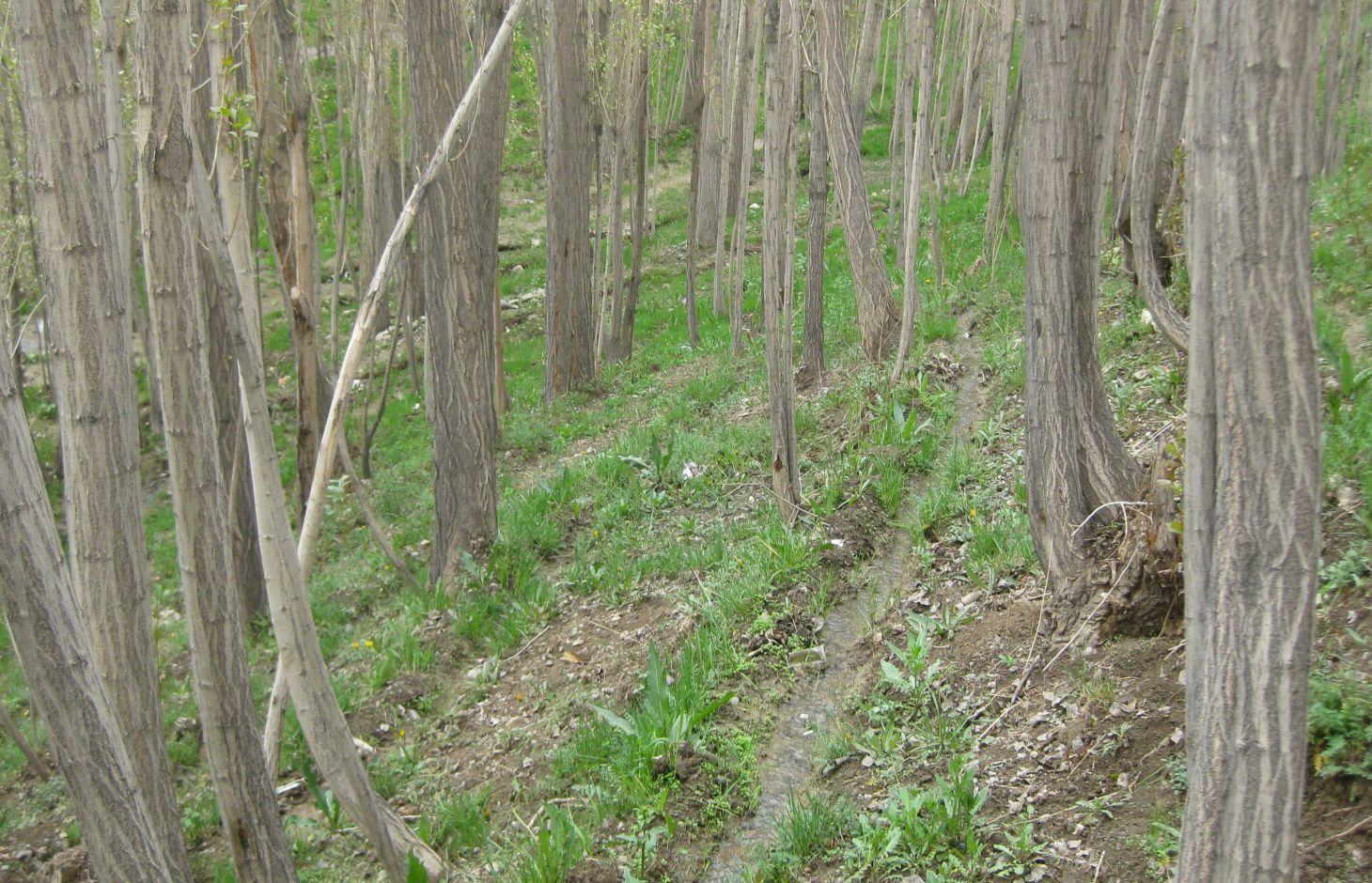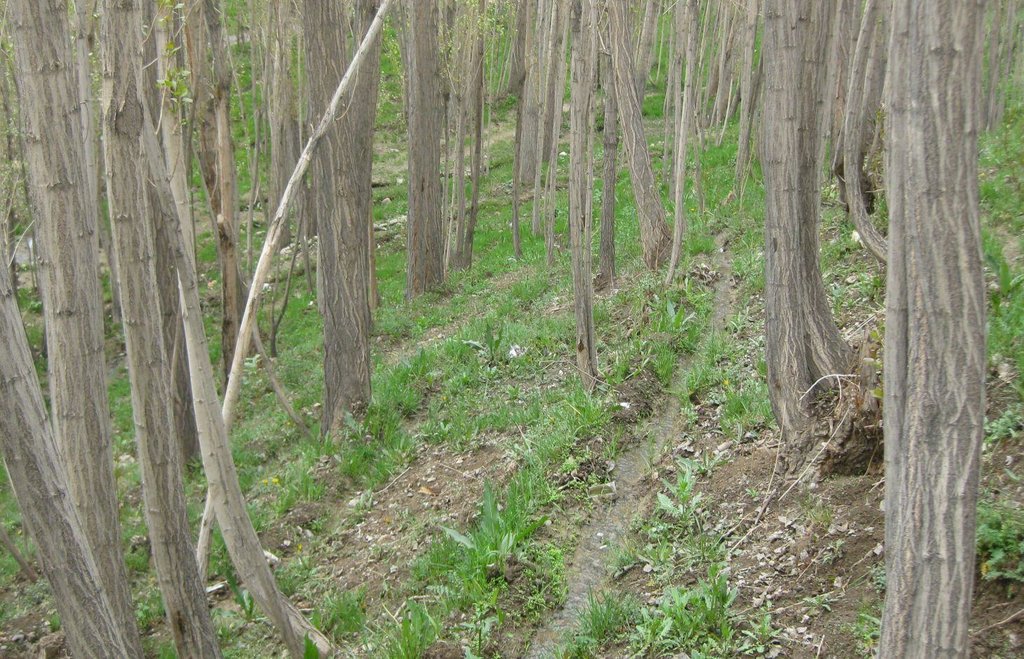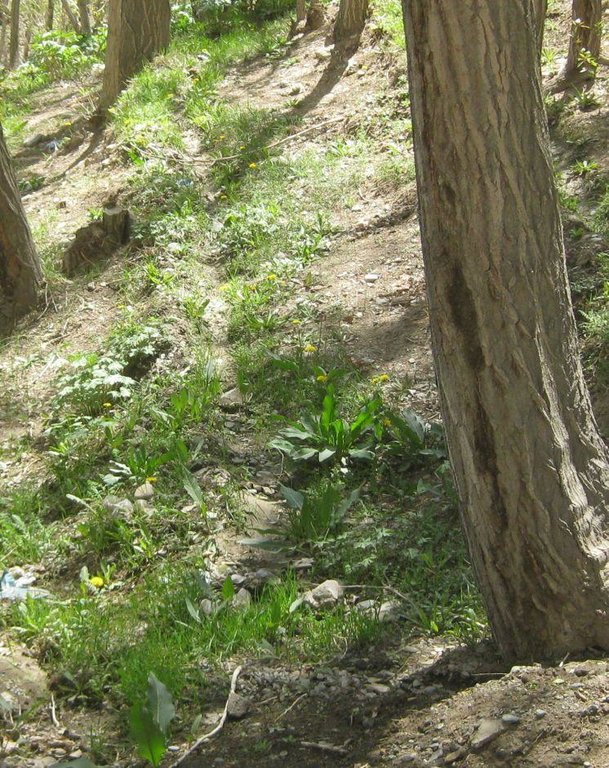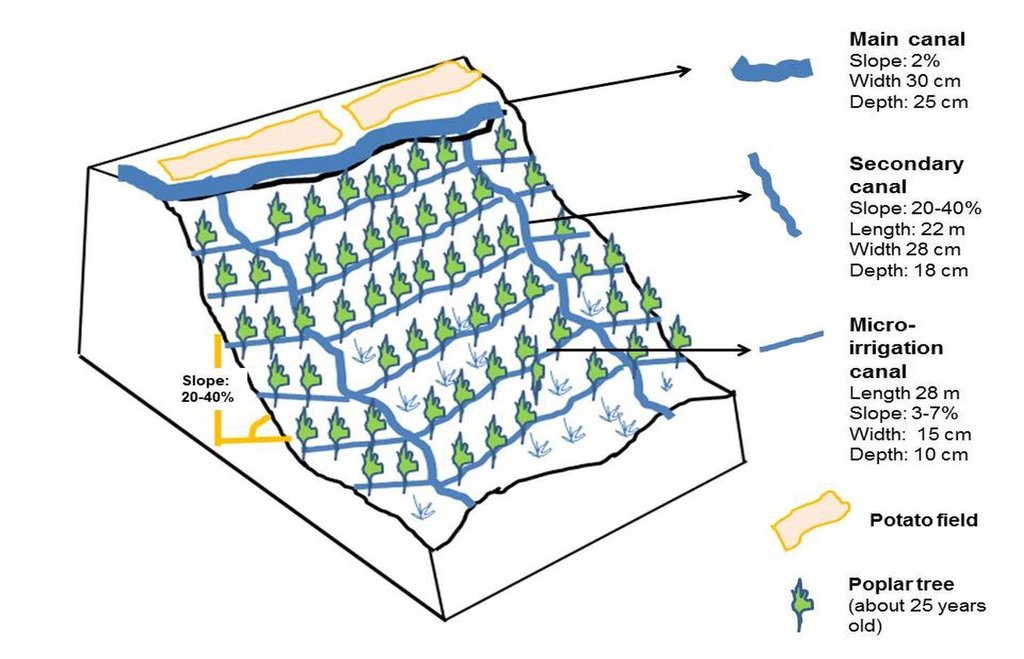Micro irrigation in poplar plantation [ប្រទេសអាហ្វហ្គានិស្ថាន]
- ការបង្កើត៖
- បច្ចុប្បន្នភាព
- អ្នកចងក្រង៖ Aqila Haidery
- អ្នកកែសម្រួល៖ –
- អ្នកត្រួតពិនិត្យ Deborah Niggli
Abyari joychayi
technologies_1603 - ប្រទេសអាហ្វហ្គានិស្ថាន
ពិនិត្យមើលគ្រប់ផ្នែក
ពង្រីកមើលទាំងអស់ បង្រួមទាំងអស់1. ព័ត៌មានទូទៅ
1.2 ព័ត៌មានលម្អិតពីបុគ្គលសំខាន់ៗ និងស្ថាប័នដែលចូលរួមក្នុងការវាយតម្លៃ និងចងក្រងឯកសារនៃបច្ចេកទេស
អ្នកជំនាញឯកទេស SLM:
អ្នកជំនាញឯកទេស SLM:
ឈ្មោះអង្គភាពមួយ (ច្រើន) ដែលបានចងក្រងឯកសារ/ វាយតម្លៃបច្ចេកទេស (បើទាក់ទង)
HELVETAS (Swiss Intercooperation)1.3 លក្ខខណ្ឌទាក់ទងទៅនឹងការប្រើប្រាស់ទិន្នន័យដែលបានចងក្រងតាមរយៈ វ៉ូខេត
តើពេលណាដែលទិន្នន័យបានចងក្រង (នៅទីវាល)?
10/05/2014
អ្នកចងក្រង និង(បុគ្គលសំខាន់ៗ)យល់ព្រមទទួលយកនូវលក្ខខណ្ឌនានាទាក់ទងទៅនឹងការប្រើប្រាស់ទិន្នន័យដែលបានចងក្រងតាមរយៈវ៉ូខេត:
បាទ/ចា៎
1.4 សេចក្តីប្រកាសស្តីពីចីរភាពនៃការពណ៌នាពីបច្ចេកទេស
តើបច្ចេកទេសដែលបានពណ៌នានេះមានបញ្ហាដែលផ្តោតលើការធ្លាក់ចុះគុណភាពដី, បើដូច្នេះវាមិនអាចត្រូវបានប្រកាសថាជាបច្ចេកទេសនៃការគ្រប់គ្រងប្រកបដោយចីរភាពទេ?
ទេ
2. ការពណ៌នាពីបច្ចេកទេស SLM
2.1 ការពណ៌នាដោយសង្ខេបពីបច្ចេកទេស
និយមន័យបច្ចេកទេស:
Micro irrigation canal system for supplying water to poplar plantations on sloping lands.
2.2 ការពណ៌នាលម្អិតពីបច្ចេកទេស
ការពណ៌នា:
The Micro Irrigation system technology is documented by SLM Project/HELVETAS Swiss Intercooperation with financial support of Swiss Agency for Development and Cooperation (SDC). The presented micro-irrigation system, a structural SLM technology, was applied in Central Highland’s Province of Bamyan (Afghanistan). The micro-irrigation technology is applied to bring marginal land under cultivation for economic benefits, with the added benefit of rehabilitating degraded sloping land. The main irrigation canal also conveys water to agricultural land. It is a traditional technology applied by a land user without external support. It is also implemented by many other land users with some variations to the technology.
The technology consists of a network of main irrigation canal, secondary canals from which water is conveyed to sloping micro irrigation canals. The water reaches to the roots of each tree through infiltration/seepage.
The main canal has about 2% gradient and the micro-channels from 2-7% gradient. The slope of the site ranges between 20-40%. A micro irrigation canal is 28 m long, 15 cm wide and 10 cm deep. While the cross section remains same, the length can differ according to the land size.
The site was originally a degraded site with gravel soil. According to the land user, the site was not at all suitable for agriculture due to soil degradation and bad water shortage possibilities. Approximately 25 years after the plantation of poplar trees, the site's physical and biological conditions of the slope have improved due to the establishment of poplar trees. The poplar trees can be used for timber for construction and firewood. The poplar timber has good market in Bamyan and can fetch up to 35 USD per tree.
The micro-irrigation systems, which help establishing poplar plantations, contribute to multiple benefits for the land user's family and also the environment. As the poplar plantations are irrigated, their growth increases and their mortality, due to water shortage, is reduced.
As a result of re-vegetating the relatively steep slope, soil erosion from the site has reduced and the fertility of the soil has improved. Improved soil moisture and fertility has also helped in establishment of a good ground canopy. Many birds visit the site for shelter. The plantation has reached its harvesting stage and the land user is planning to cut the trees for sale, expecting an income of about 10,500 USD from the site.
A close look at this technology shows that the system works well and that it is easily managed by the land user. Some minor improvements, such as reducing the slope gradient of the micro-irrigation canals for reducing canal erosion, construction of pits to capture sediments at the drainage points and planting suitable grasses with good roots along the canal bunds could make the system more effective and sustainable. The measures could also help in reducing the sensitivity of the micro-irrigation canals towards intense rainfall.
The farmers are applying this SLM technology without any external financial or technical support and there is growing trend towards spontaneous adoption. According to the land user's estimate, of about 400 families in his village, 80 families have applied the technology
The basic purpose of the micro-irrigation system is to supply irrigation water to the poplar trees for reducing plant mortality and increasing plant growth.
The main establishment activities include layout of the micro canals across the sloping land using shovels and pick axe without use of any alignment equipment. Approximately 150 persons-days/ha were employed for constructing the micro-irrigation canals and 5 person-days/ha sufficed for on-site maintenance works. About 970 USD/ha was spent on the construction and most of the cost for labour was covered by the family of the owner.
The site is owned by a land user with clear land use rights. The water rights are common and organized as there is a traditional social water management institution (Mirab), which ensures an equitable distribution of irrigation water to all the farmers taking water from the main canal. A command area on a turn-by-turn basis exists. Water users pay service fees to the Mirab mostly in kind. The land users mentioned that they give about 14 kg of wheat and/or potato each year to the Mirab for this site. The land user has to also participate in main canal repair works on a voluntary basis. Bamyan Centre receives about 230 mm rainfall per year. Most of the rain falls in the months of April and May. Winters are severe with temperatures falling below minus 20 degrees. The area receives snowfall up to 180 cm per year in normal years. Bamyan center has an arid and temperate climate with one main growing season of about 6 months, which is from April to September. The plantation site is located at an altitude of about 2300 m. It is north-facing slope with a soil depth of about 30-50 cm. The soil is sandy loam with a medium soil fertility.
2.3 រូបភាពនៃបច្ចេកទេស
2.5 ប្រទេស/តំបន់/ទីតាំងកន្លែង ដែលបច្ចេកទេសត្រូវបានអនុវត្ត និងបានគ្រប់ដណ្តប់ដោយការវាយតម្លៃនេះ
ប្រទេស:
ប្រទេសអាហ្វហ្គានិស្ថាន
តំបន់/រដ្ឋ/ខេត្ត:
Bamyan
បញ្ជាក់បន្ថែមពីលក្ខណៈនៃទីតាំង:
Bamyan center
2.6 កាលបរិច្ឆេទនៃការអនុវត្ត
ប្រសិនបើមិនច្បាស់ឆ្នាំ សូមបញ្ជាក់កាលបរិច្ឆេទដែលប្រហាក់ប្រហែល:
- 10-50 ឆ្នាំ
2.7 ការណែនាំពីបច្ចេកទេស
សូមបញ្ជាក់តើបច្ចេកទេសត្រូវបានណែនាំឱ្យអនុវត្តដោយរបៀបណា:
- តាមរយៈការបង្កើតថ្មីរបស់អ្នកប្រើប្រាស់ដី
មតិយោបល់ (ប្រភេទនៃគម្រោង ។ល។):
The technology is being applied on the site since about 25 years.
3. ចំណាត់ថ្នាក់នៃបច្ចេកទេស SLM
3.1 គោលបំណងចម្បង (១ ឬច្រើន) នៃបច្ចេកទេសនេះ
- ធ្វើឱ្យប្រសើរឡើងនូវផលិតកម្ម
3.2 ប្រភេទដីប្រើប្រាស់មួយប្រភេទ (ច្រើនប្រភេទ) ដែលបានអនុវត្តបច្ចេកទេស

ដីព្រៃ/ដីដាំដើមឈើ
ព្រៃ (ពាក់កណ្តាល) ធម្មជាតិ/ ដីព្រៃ:
- កាប់តែមួយចំនួន
ការដាំដើមឈើ ការដាំព្រៃឡើងវិញ:
- ឯកវប្បកម្មដែលប្រើពូជក្នុងតំបន់
ផលិតផល និងសេវាកម្ម:
- ឈើហ៊ុប
- អុស
មតិយោបល់:
Major land use problems (compiler’s opinion): Gravely site, shortage of water for irrigation, sloping land affected by soil erosion. Heavy shrub harvesting for firewood and overgrazing on common/rangeland leading to land degradation.
Major land use problems (land users’ perception): Sloping land with sandy soil unsuitable for agriculture.
Plantation forestry: Plantation of poplar trees (mono culture)
Problems / comments regarding forest use: Land users do selective felling when they need cash. The trees are lopped for fuel wood.
Future (final) land use (after implementation of SLM Technology): Forests / woodlands: Fp: Plantations, afforestations
3.3 ព័ត៌មានបន្ថែមអំពីអ្នកប្រើប្រាស់ដី
ចំនួនសារដែលដាំដំណាំក្នុងមួយឆ្នាំ:
- 1
សូមបញ្ជាក់:
Longest growing period in days: 170, Longest growing period from month to month: April to September in the valley bottom
3.4 ក្រុម SLM ដែលបច្ចេកទេសស្ថិតនៅក្នុង
- ការគ្រប់គ្រងប្រព័ន្ធស្រោចស្រព (រួមទាំងការផ្គត់ផ្គង់ទឹក ប្រព័ន្ធបង្ហូរ)
3.5 ការសាយភាយនៃបច្ចេកទេស
បញ្ជាក់ពីការសាយភាយនៃបច្ចេកទេស:
- ត្រូវបានផ្សព្វផ្សាយត្រឹមតំបន់មួយ
ប្រសិនបើបច្ចេកទេសត្រូវបានសាយភាយពាសពេញតំបន់ណាមួយ សូមកំណត់ទំហំផ្ទៃដីអនុវត្តន៍:
- 0.1-1 គម2
មតិយោបល់:
Total area covered by the SLM Technology is 0.16 m2.
3.6 វិធានការ SLM ដែលបញ្ចូលនូវបច្ចេកទេស

វិធានការរចនាស័ម្ពន្ធ
- S3: កម្ពស់ភ្លឺ ប្រឡាយ ផ្លូវទឹក
3.7 កំណត់ប្រភេទនៃការធ្លាក់ចុះគុណភាពដីសំខាន់ៗដែលបច្ចេកទេសនេះបានដោះស្រាយ

ការធ្លាក់ចុះជីវសាស្ត្រនៃដី
- Bc: ការថយចុះនូវគម្របរុក្ខជាតិ

ការបាត់បង់ទឹក
- Ha: ការថយចុះសំណើមដី
មតិយោបល់:
Main causes of degradation: over-exploitation of vegetation for domestic use (Particulary for firewood), overgrazing (Mainly by sheep and goats), population pressure, inputs and infrastructure: (roads, markets, distribution of water points, other, …) (Lack of irrigation water), governance / institutional (Specifically in the case of common lands)
Secondary causes of degradation: droughts
3.8 ការពារ កាត់បន្ថយ ឬស្តារឡើងវិញនៃការធ្លាក់ចុះគុណភាពដី
បញ្ជាក់ពីគោលដៅរបស់បច្ចេកទេស ដែលផ្តោតទៅការធ្លាក់ចុះគុណភាពដី:
- ការកាត់បន្ថយការធ្លាក់ចុះគុណភាពដី
4. បច្ចេកទេសជាក់លាក់ សកម្មភាពអនុវត្ត ធាតុចូល និងថ្លៃដើម
4.1 គំនូសបច្ចេកទេសនៃបច្ចេកទេសនេះ
4.2 លក្ខណៈពិសេសនៃបច្ចេកទេស/ ពណ៌នាពីគំនូរបច្ចេកទេស
Technical specifications of micro-irrigation system for poplar plantation. The system comprises main canal, secondary canals and micro irrigation canals which receive water from and drain into secondary canals.
Location: Tape Chauni. Bamyan Centre
Date: 10 May 2014
Technical knowledge required for field staff / advisors: low
Technical knowledge required for land users: low
Main technical functions: water harvesting / increase water supply
Secondary technical functions: increase of biomass (quantity)
Vertical interval between structures (m): 0.22-0.6
Spacing between structures (m): 1.8-2
Depth of ditches/pits/dams (m): 0.1
Width of ditches/pits/dams (m): 0.15
Length of ditches/pits/dams (m): 0.28
Construction material (earth): Soil from the site is used for canal consturction
Slope (which determines the spacing indicated above): 20-40%
Lateral gradient along the structure: 3-7%
4.3 ព័ត៌មានទូទៅដែលពាក់ព័ន្ធនឹងការគណនាធាតុចូល និងថ្លៃដើម
ផ្សេងៗ/ រូបិយប័ណ្ណជាតិ (បញ្ជាក់):
Afghani
កំណត់អត្រាប្តូរប្រាក់ពីដុល្លាទៅរូបិយប័ណ្ណតំបន់ (បើទាក់ទង)៖ 1 ដុល្លារ =:
57,0
កំណត់ថ្លៃឈ្នួលជាមធ្យមនៃការជួលកម្លាំងពលកម្មក្នុងមួយថ្ងៃ:
70.00
4.4 សកម្មភាពបង្កើត
| សកម្មភាព | ប្រភេទវិធានការ | ពេលវេលា | |
|---|---|---|---|
| 1. | Construction of secondary and micro-irrigation canals | រចនាសម្ព័ន្ធ | Spring |
4.5 ថ្លៃដើម និងធាតុចូលដែលត្រូវការសម្រាប់ការបង្កើតបច្ចេកទេស
| បញ្ជាក់ពីធាតុចូល | ឯកតា | បរិមាណ | ថ្លៃដើមក្នុងមួយឯកតា | ថ្លៃធាតុចូលសរុប | % នៃថ្លៃដើមដែលចំណាយដោយអ្នកប្រើប្រាស់ដី | |
|---|---|---|---|---|---|---|
| កម្លាំងពលកម្ម | labour | ha | 1,0 | 921,0 | 921,0 | 100,0 |
| សម្ភារៈ | tools | ha | 1,0 | 52,0 | 52,0 | 100,0 |
| ថ្លៃដើមសរុបក្នុងការបង្កើតបច្ចេកទេស | 973,0 | |||||
មតិយោបល់:
Duration of establishment phase: 0.25 month(s)
4.6 សកម្មភាពថែទាំ
| សកម្មភាព | ប្រភេទវិធានការ | ពេលវេលា/ ភាពញឹកញាប់ | |
|---|---|---|---|
| 1. | Maintenance of canals | រចនាសម្ព័ន្ធ | Spring/once per year |
4.7 កំណត់ថ្លៃដើមសម្រាប់ការថែទាំ/ សកម្មភាពរបស់បច្ចេកទេស (ក្នុងរយៈពេលមួយឆ្នាំ)
| បញ្ជាក់ពីធាតុចូល | ឯកតា | បរិមាណ | ថ្លៃដើមក្នុងមួយឯកតា | ថ្លៃធាតុចូលសរុប | % នៃថ្លៃដើមដែលចំណាយដោយអ្នកប្រើប្រាស់ដី | |
|---|---|---|---|---|---|---|
| កម្លាំងពលកម្ម | labour | ha | 1,0 | 30,0 | 30,0 | 100,0 |
| សម្ភារៈ | tools | ha | 1,0 | 52,0 | 52,0 | 100,0 |
| ថ្លៃដើមសរុបសម្រាប់ការថែទាំដំណាំតាមបច្ចេកទេស | 82,0 | |||||
មតិយោបល់:
Machinery/ tools: Pick axe and shovels
The presented costs were calculated on the basis of the exisiting local labour rate and the currency exchange rate which may vary from one year to another. For instance in 2010/11, 1 USD was 50 Afghani.
The cost of payment to the Mirab (Water distributor appointed by the land users) is not included. According to the land user, the Mirabs receive about 700 kg wheat/year from all the land users who use the main canal.
4.8 កត្តាសំខាន់បំផុតដែលមានឥទ្ធិពលដល់ការចំណាយ
ពណ៌នាពីកត្តាប៉ះពាល់ចម្បងៗទៅលើថ្លៃដើម:
Labour is the most determinate factor affecting the costs. All the work is done manually.
5. លក្ខណៈបរិស្ថានធម្មជាតិ និងមនុស្ស
5.1 អាកាសធាតុ
បរិមាណទឹកភ្លៀងប្រចាំឆ្នាំ
- < 250 មម
- 251-500 មម
- 501-750 មម
- 751-1,000 មម
- 1,001-1,500 មម
- 1,501-2,000 មម
- 2,001-3,000 មម
- 3,001-4,000 មម
- > 4,000 មម
លក្ខណៈពិសេស/ មតិយោបល់លើរដូវភ្លៀង:
Most rainfall is in May. According to provincial agriculture department, Bamyan centre receives about 230 mm rain a year
តំបន់កសិអាកាសធាតុ
- មានភ្លៀងតិចតួច
Thermal climate class: temperate. Winter temperatures can go below minus 20 degree C and maximum in summer up to 34 degree C
5.2 សណ្ឋានដី
ជម្រាលជាមធ្យម:
- រាបស្មើ (0-2%)
- ជម្រាលតិចតួច (3-5%)
- មធ្យម (6-10%)
- ជម្រាលខ្ពស់បន្តិច (11-15%)
- ទីទួល (16-30%)
- ទីទួលចោត (31-60%)
- ទីទួលចោតខ្លាំង (>60%)
ទម្រង់ដី:
- ខ្ពង់រាប
- កំពូលភ្នំ
- ជម្រាលភ្នំ
- ជម្រាលទួល
- ជម្រាលជើងភ្នំ
- បាតជ្រលងភ្នំ
តំបន់តាមរយៈកម្ពស់ :
- 0-100 ម
- 101-500 ម
- 501-1,000 ម
- 1,001-1,500 ម
- 1,501-2,000 ម
- 2,001-2,500 ម
- 2,501-3,000 ម
- 3,001-4,000 ម
- > 4,000 ម
5.3 ដី
ជម្រៅដីជាមធ្យម:
- រាក់ខ្លាំង (0-20 សម)
- រាក់ (21-50 សម)
- មធ្យម (51-80 សម)
- ជ្រៅ (81-120 សម)
- ជ្រៅខ្លាំង (> 120 សម)
វាយនភាពដី (ស្រទាប់លើ):
- គ្រើម/ មានពន្លឺ (ខ្សាច់)
- មធ្យម (ល្បាយ, ល្បាប់)
សារធាតុសរីរាង្គនៅស្រទាប់ដីខាងលើ:
- មធ្យម (1-3%)
5.4 ទឹកដែលអាចទាញមកប្រើប្រាស់បាន និងគុណភាពទឹក
នីវ៉ូទឹកក្រោមដី:
5-50 ម
ទឹកលើដីដែលអាចទាញយកប្រើប្រាស់បាន:
ល្អ
គុណភាពទឹក (មិនបានធ្វើប្រត្តិកម្ម):
ទឹកសម្រាប់តែការធ្វើកសិកម្ម (ស្រោចស្រព)
5.5 ជីវៈចម្រុះ
ភាពសម្បូរបែបនៃប្រភេទ:
- កម្រិតមធ្យម
5.6 លក្ខណៈនៃអ្នកប្រើប្រាស់ដីដែលអនុវត្តបច្ចេកទេស
ទីផ្សារនៃប្រព័ន្ធផលិតកម្ម:
- ពាក់កណ្តាលពាណិជ្ជកម្ម (ផ្គត់ផ្គង់ខ្លួនឯង/ ពាណិជ្ជកម្ម
ចំណូលក្រៅកសិកម្ម:
- 10-50% នៃចំណូល
កម្រិតជីវភាព:
- មធ្យម
ឯកជន ឬក្រុម:
- ធ្វើខ្លួនឯង/ គ្រួសារ
យេនឌ័រ:
- បុរស
សូមបញ្ជាក់ពីលក្ខណៈពាក់ព័ន្ធផ្សេងទៀតអំពីអ្នកប្រើប្រាស់ដី:
Land users applying the Technology are mainly common / average land users
Difference in the involvement of women and men: Women are however involved in other agriculture works but at the plantation site, they are not involved at all. The land user has about 0.4 ha irrigated crop land used for potato and wheat cultivation on a rotation basis.
Population density: 10-50 persons/km2
Annual population growth: 2% - 3%
Off-farm income specification: The land user family is food secure from its own production for up to 6 months only. For food security for 12 months, they have to depend on other sources of off farm income. The agriculture land is not enough to meet all the family needs.
5.7 ទំហំផ្ទៃដីជាមធ្យមនៃដីផ្ទាល់ខ្លួន ឬជួលគេដែលបានអនុវត្តបច្ចេកទេស
- < 0.5 ហិកតា
- 0.5-1 ហិកតា
- 1-2 ហិកតា
- 2-5 ហិកតា
- 5-15 ហិកតា
- 15-50 ហិកតា
- 50-100 ហិកតា
- 100-500 ហិកតា
- 500-1,000 ហិកតា
- 1,000-10,000 ហិកតា
- > 10,000 ហិកតា
តើផ្ទៃដីនេះចាត់ទុកជាទំហំកម្រិតណាដែរ ខ្នាតតូច មធ្យម ឬខ្នាតធំ (ធៀបនឹងបរិបទតំបន់)?
- ខ្នាតតូច
5.8 ភាពជាម្ចាស់ដី កម្មសិទ្ធប្រើប្រាស់ដី និងកម្មសិទ្ធប្រើប្រាស់ទឹក
ភាពជាម្ចាស់ដី:
- ឯកជន មានកម្មសិទ្ធ
កម្មសិទ្ធិប្រើប្រាស់ដី:
- កិច្ចសន្យាជួល
កម្មសិទ្ធប្រើប្រាស់ទឹក:
- ជាក្រុម (មានដែនកំណត់)
មតិយោបល់:
For water distribution, there is a traditional system called as Mirab which is applied for the plantations as well. The land user applying the plantation/micro-irrigation technique have to participate in main irrigation canal repair and cleaning works. The land user also has to pay in kind or cash to the Mirab for his services.
5.9 ការប្រើប្រាស់សេវាកម្ម និងហេដ្ឋារចនាសម្ព័ន្ធ
សុខភាព:
- មិនល្អ
- មធ្យម
- ល្អ
ការអប់រំ:
- មិនល្អ
- មធ្យម
- ល្អ
ជំនួយបច្ចេកទេស:
- មិនល្អ
- មធ្យម
- ល្អ
ការងារ (ឧ. ការងារក្រៅកសិដ្ឋាន):
- មិនល្អ
- មធ្យម
- ល្អ
ទីផ្សារ:
- មិនល្អ
- មធ្យម
- ល្អ
ថាមពល:
- មិនល្អ
- មធ្យម
- ល្អ
ផ្លូវ និងការដឹកជញ្ជូន:
- មិនល្អ
- មធ្យម
- ល្អ
ទឹកផឹក និងអនាម័យ:
- មិនល្អ
- មធ្យម
- ល្អ
សេវាកម្មហិរញ្ញវត្ថុ:
- មិនល្អ
- មធ្យម
- ល្អ
6. ផលប៉ះពាល់ និងការសន្និដ្ឋាន
6.1 ផលប៉ះពាល់ក្នុងបរិវេណអនុវត្តបច្ចេកទេសដែលកើតមាន
ផលប៉ះពាល់លើសេដ្ឋកិច្ចសង្គម
ផលិតផល
ផលិតកម្មចំណីសត្វ
ផលិតកម្មឈើ
មតិយោបល់/ ការបញ្ជាក់:
Irrigation helps in Poplar establishment and growth
ហានិភ័យនៃភាពបរាជ័យរបស់ផលិតកម្ម
មតិយោបល់/ ការបញ្ជាក់:
Important for reducing plant mortality
ផ្ទៃដីផលិតកម្ម
មតិយោបល់/ ការបញ្ជាក់:
The area was degraded before
ការបង្កើតថាមពល
ទឹកដែលអាចទាញមកប្រើប្រាស់បាន និងគុណភាពទឹក
ទឹកប្រើប្រាស់សម្រាប់ស្រោចស្រព
មតិយោបល់/ ការបញ្ជាក់:
For plantations
ចំណូល និងថ្លៃដើម
ចំណូលក្នុងកសិដ្ឋាន
មតិយោបល់/ ការបញ្ជាក់:
From sale of poplar trees but only in the long term
បន្ទុកការងារ
មតិយោបល់/ ការបញ្ជាក់:
Irrigation needs more time and labour
ផលប៉ះពាល់ទៅលើវប្បធម៌សង្គម
ឱកាសនៃការបង្កើតថ្មី
ចំណេះដឹង SLM / ការធ្លាក់ចុះគុណភាពដី
មតិយោបល់/ ការបញ្ជាក់:
Other land users see and learn
ការកាត់បន្ថយជម្លោះ
Fuel wood sufficiency
មតិយោបល់/ ការបញ្ជាក់:
Lopped branches are used for fuel wood
contribution to human well-being
មតិយោបល់/ ការបញ្ជាក់:
The technology contributes to increased household income in the long term and also towards increased production of fodder, fuel wood and timber.
ផលប៉ះពាល់ទៅលើអេកូឡូស៊ី
ដី
សំណើមដី
សារធាតុសរីរាង្គដី/ការបូនក្រោមដី
មតិយោបល់/ ការបញ្ជាក់:
Due to build of humus and ground cover
ជីវចម្រុះ៖ ដំណាំ, សត្វ
ជីវម៉ាស/ កាបូនលើដី
មតិយោបល់/ ការបញ្ជាក់:
Due to plantations
ភាពសម្បូរបែបនៃរុក្ខជាតិ
មតិយោបល់/ ការបញ្ជាក់:
due to increased soil moisture
ភាពសម្បូរបែបនៃសត្វ
មតិយោបល់/ ការបញ្ជាក់:
habitat for birds
ការគ្រប់គ្រងកត្តាចង្រៃ/ ជំងឺ
ការកាត់បន្ថយហានិភ័យនៃគ្រោះមហន្តរាយ និងគ្រោះអាកាសធាតុ
ល្បឿនខ្យល់
មតិយោបល់/ ការបញ្ជាក់:
Due to plantations (indirect impact)
6.2 ផលប៉ះពាល់ក្រៅបរិវេណអនុវត្តបច្ចេកទេសដែលកើតមាន
Buffering/សមត្ថភាពចម្រោះ
មតិយោបល់/ ការបញ្ជាក់:
Due to plantations
ខ្យល់នាំយកនូវធូរលី
មតិយោបល់/ ការបញ្ជាក់:
Plantations impact
ខូចខាតដល់ហេដ្ឋារចនាសម្ព័ន្ធសាធារណៈ/ឯកជន
មតិយោបល់/ ការបញ្ជាក់:
Due to less sedimentation and runoff from the site
6.3 ភាពប្រឈម និងភាពរួសនៃបច្ចេកទេសទៅនឹងការប្រែប្រួលអាកាសធាតុ និងគ្រោះអាកាសធាតុ/ គ្រោះមហន្តរាយ (ដែលដឹងដោយអ្នកប្រើប្រាស់ដី)
ការប្រែប្រួលអាកាសធាតុ
ការប្រែប្រួលអាកាសធាតុ
| រដូវកាល | ប្រភេទនៃការប្រែប្រួលអាកាសធាតុ/ព្រឹត្តិការណ៍ | លក្ខណៈឆ្លើយតបនៃបច្ចេកទេសទៅនឹងការប្រែប្រួលអាកាសធាតុ | |
|---|---|---|---|
| សីតុណ្ហភាពប្រចាំឆ្នាំ | កើនឡើង | ល្អ |
គ្រោះអាកាសធាតុ (មហន្តរាយ)
គ្រោះមហន្តរាយធម្មជាតិ
| លក្ខណៈឆ្លើយតបនៃបច្ចេកទេសទៅនឹងការប្រែប្រួលអាកាសធាតុ | |
|---|---|
| ព្យុះភ្លៀងតាមតំបន់ | មិនល្អ |
គ្រោះមហន្តរាយអាកាសធាតុ
| លក្ខណៈឆ្លើយតបនៃបច្ចេកទេសទៅនឹងការប្រែប្រួលអាកាសធាតុ | |
|---|---|
| រាំងស្ងួត | មិនល្អ |
គ្រោះមហន្តរាយទឹក
| លក្ខណៈឆ្លើយតបនៃបច្ចេកទេសទៅនឹងការប្រែប្រួលអាកាសធាតុ | |
|---|---|
| ទឹកជំនន់ទូទៅ (ទន្លេ) | មិនល្អ |
មតិយោបល់:
Stabilize the technology with grasses and reduce the slope of the channels so that it is less sensitive to increase in rainfall intensities.
6.4 ការវិភាគថ្លៃដើម និងអត្ថប្រយោជន៍
តើផលចំណេញ និងថ្លៃដើមត្រូវបានប្រៀបធៀបគ្នាយ៉ាងដូចម្តេច (ទស្សនៈរបស់អ្នកប្រើប្រាស់ដី)?
រយៈពេលខ្លី:
អវិជ្ជមាន
រយៈពេលវែង:
វិជ្ជមានខ្លាំង
តើផលចំណេញ និងការថែទាំ/ ជួសជុលត្រូវបានប្រៀបធៀបគ្នាយ៉ាងដូចម្តេច (ទស្សនៈរបស់អ្នកប្រើប្រាស់ដី)?
រយៈពេលខ្លី:
អវិជ្ជមានតិចតួច
រយៈពេលវែង:
វិជ្ជមានខ្លាំង
មតិយោបល់:
The returns in the form of cash start coming after 10-12 years with this poplar variety following a selective felling and replanting approach.
6.5 ការទទួលយកបច្ចេកទេស
ក្នុងចំណោមគ្រួសារទាំងអស់ដែលអនុវត្តបច្ចេកទេស តើមានប៉ុន្មានគ្រួសារដែលចង់ធ្វើដោយខ្លួនឯង ដោយមិនទទួលបានសម្ភារៈលើកទឹកចិត្ត/ប្រាក់ឧបត្ថម្ភ?:
- 90-100%
មតិយោបល់:
100% of land user families have adopted the Technology without any external material support
80 land user families have adopted the Technology without any external material support
The total area under this plantation in the village is estimated to be 16 ha (80 jerib)
There is a small growing trend towards the adoption of the technology by communities and individuals in the area. Adoption depends on (and is hampered by) the availability of a reliable water source near the sites with potential for plantation and also about the land.
6.7 ភាពខ្លាំង/ គុណសម្បត្តិ/ ឱកាសនៃបច្ចេកទេស
| ភាពខ្លាំង/ គុណសម្បត្តិ/ ឱកាសនៅកន្លែងរបស់អ្នកប្រើប្រាស់ដី |
|---|
| The technology helps successful establishment of poplar trees and also natural grasses on sloping lands. |
| ភាពខ្លាំង/ គុណសម្បត្តិ/ ឱកាស ទស្សនៈរបស់បុគ្គលសំខាន់ៗ |
|---|
| Micro-irrigation technology is important for the establishment and maintenance of poplar plantations. The technology is adapted for afforestation of sloping land. |
| The technology does not require much maintenance once the plantations are well established. A special attention need to be given to the secondary canals. |
| No external support for establishing or maintaining the technology. |
| The technology helps in improving the site's micro climate which leads to more plant and animal (bird) diversity. |
6.8 ភាពខ្សោយ/ គុណវិបត្តិ/ ហានិភ័យនៃបច្ចេកទេស និងវិធីសាស្ត្រដោះស្រាយ
| ភាពខ្សោយ/ គុណវិបត្តិ/ ហានិភ័យ ទស្សនៈរបស់អ្នកប្រើប្រាស់ដី | តើបច្ចេកទេសទាំងនោះបានដោះស្រាយបញ្ហាដូចម្តេច? |
|---|---|
| There is no information available regarding the land user's view on the weaknesses of this technology. |
| ភាពខ្សោយ/ គុណវិបត្តិ/ ហានិភ័យ ទស្សនៈរបស់អ្នកចងក្រងឬបុគ្គលសំខាន់ៗ | តើបច្ចេកទេសទាំងនោះបានដោះស្រាយបញ្ហាដូចម្តេច? |
|---|---|
| The canals break at some weak points. Also the slopes of the micro channels is more at many places leading to some soil erosion. | Proper alignment of micro-irrigation canals. |
| Rill and gully erosion due to rapid and uncontrolled flow of excessive drainage in secondary canals. | Plant grasses with robust root system along the canals. Strengthen points where water spills from the micro-irrigation canals into the secondary canals with vegetative measures and sediment pits. |
| Due to small sizes of the channels, irrigation needs more time and labour. | Improvements in micro irrigation canals will reduce this problem considering. Interested organisations could carry out action research on how to improve this system by also incorporating efficient water use measures. |
| The technology can be applied only when there is a reliable source of running water. | Action research on soil and water conservation techniques for plantations in areas where there is no easy access to irrigation water. |
7. ឯកសារយោង និងវេបសាយ
7.1 វិធីសាស្ត្រ/ ប្រភពនៃព័ត៌មាន
- តាមការចុះទីវាល ការស្រាវជ្រាវនៅទីវាល
- ការសម្ភាសន៍ជាមួយអ្នកប្រើប្រាស់ដី
ការតភ្ជាប់ និងម៉ូឌុល
ពង្រីកមើលទាំងអស់ បង្រួមទាំងអស់ការតភ្ជាប់
គ្មានការតភ្ជាប់
ម៉ូឌុល
គ្មានម៉ូឌុល





